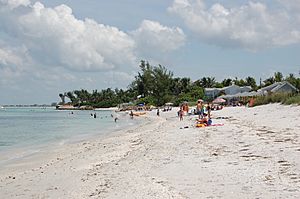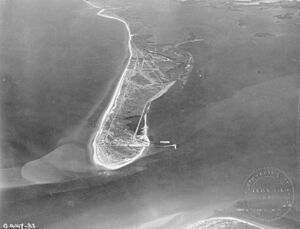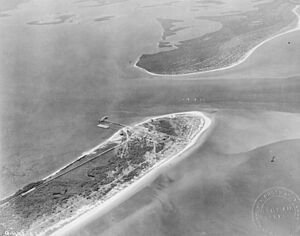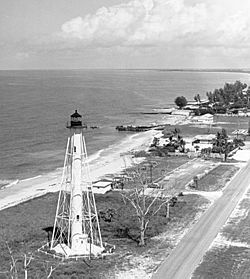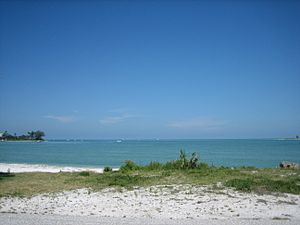Boca Grande, Florida facts for kids
Boca Grande is a small, quiet community located on Gasparilla Island in southwest Florida. Gasparilla Island is split between Charlotte and Lee counties. However, the main village of Boca Grande is entirely within the Lee County part of the island. It is part of the larger Cape Coral-Fort Myers, Florida Metropolitan Statistical Area. Boca Grande is famous for its old-fashioned downtown, beautiful white sand beaches, clear blue water, and amazing fishing.
What is Boca Grande?
The name "Boca Grande" means "Big Mouth" in Spanish. This name comes from the wide waterway called Boca Grande Pass. This pass separates the southern tip of Gasparilla Island from Cayo Costa. For many years, this pass was a very busy shipping area because its waters are naturally deep.
Phosphate Shipping History
Years ago, a mineral called phosphate was shipped from Boca Grande. Phosphate was used to make fertilizers. It came from the Bone Valley area and was loaded onto large ships at a dock on the island's southern tip. Shipping phosphate from Boca Grande became less common in the late 1970s. It was cheaper to ship it from Tampa instead. You can still see signs of the island's industrial past today.
Getting Around the Island
There are almost no gas stations in Boca Grande. Because of this, many people use golf carts to get around. Most streets are even set up for golf carts. You need to be at least 14 years old to drive a golf cart on these special streets.
Boca Grande in Movies
Boca Grande has been used as a filming location for movies. The movie Out of Time, starring Denzel Washington, was filmed here. The quiet village was called "Banyan Key" in the movie. Scenes for the 2006 film Hoot, based on Carl Hiaasen's book, were also filmed on the island. In that movie, the island was called "Coconut Cove."
Famous Visitors
Boca Grande's calm and beautiful scenery makes it a popular spot for special weddings. It's also a place where famous people like to have homes for privacy. For example, Sara Blakely, who started Spanx, got married here in 2008. The Bush family and Audrey Hepburn have also spent time on the island.
Hurricane Charley
On August 13, 2004, Hurricane Charley hit Boca Grande hard. It caused a lot of damage to buildings and many large banyan trees. Luckily, no one was hurt or died on the island during the storm.
Island History
The first people known to live on Gasparilla Island were the Calusa people. They lived on nearby Useppa Island around 5,000 BC and on Gasparilla Island by 800 or 900 AD. The Charlotte Harbor area was the center of their large empire. The Calusa were skilled hunters and fishers who lived in harmony with nature. They were a powerful group in Southwest Florida for many years.
Early European Contact
The Calusa did not have a written language. We know about them from stories passed down by the Seminoles, writings from Spanish explorers, and things found by archaeologists. The Calusa first met Europeans in the early 1500s when Spanish explorers arrived. By the mid-1700s, most of the Calusa people were gone. This was due to European diseases, being forced into labor, and wars.
Fishing Villages
After the Calusa, new settlers came to Gasparilla Island to fish. By the late 1870s, several "fish ranches" were set up in the Charlotte Harbor area. One of these was on the north end of Gasparilla Island. Fishermen, many from Spain or Cuba, caught a lot of mullet and other fish. They salted the fish to send them to places like Havana. In the 1940s, the main fishing business moved to Placida, across the bay. Many families in Boca Grande today are descendants of these early fishing families.
Phosphate and the Railroad
In 1885, phosphate rock was found near the Peace River, east of Gasparilla Island. This discovery turned the south end of Gasparilla Island into a major deep-water port. Boca Grande Pass is one of Florida's deepest natural inlets. This discovery, along with the great fishing, really "put Boca Grande on the map."
Phosphate was very important for fertilizers and other products around the world. At first, phosphate was brought by barges to Port Boca Grande. Then it was loaded onto ships. By 1905, people decided that building a railroad to Port Boca Grande would be a better way to ship the phosphate.
The Charlotte Harbor and Northern Railroad was finished in 1907. For the next 50 years, phosphate was shipped from this modern port. Trains loaded with phosphate would unload directly onto large ships. These ships then carried the phosphate all over the world. In 1969, Port Boca Grande was the fourth busiest port in Florida.
End of the Phosphate Era
In the 1970s, phosphate companies started using ports in other Florida counties more often. Shipping from Port Boca Grande began to slow down. In 1979, the railroad line was closed, and the phosphate industry in Boca Grande ended. The port was also used to store oil until 2001. The large oil tanks were later removed. People on the island are now working to make this land part of the state park system.
Tourism Begins
The railroad not only brought phosphate to Gasparilla Island, but it also brought wealthy people from the north. By 1910, Boca Grande Pass was already famous for its amazing tarpon fishing. People who came to fish often stayed on nearby Useppa Island. The Agrico Company, which owned the phosphate business, saw the potential to develop Gasparilla Island beyond just the port.
The railroad station was built in what became downtown Boca Grande. Roads, sidewalks, streetlights, shops, a post office, and water and phone services soon followed. The town was beautifully landscaped, including the famous Banyan Street. The railroad company built several small homes, and wealthy families from the north bought land to build winter homes.
In 1911, the first hotel, the Gasparilla Inn, opened. The island became a popular vacation spot for important people from places like Tampa, Fort Myers, and New England. Even though shipping has decreased a lot since the 1900s, tourism is still very important to the island's economy.
Changes in Travel
In 1925, the Seaboard Air Line Railroad bought the Charlotte Harbor and Northern Railway. Passenger trains continued to run daily from Tampa to Boca Grande. However, in 1958, the Boca Grande Causeway opened. This bridge made it much faster to drive to Boca Grande than to take the train. Because of this, passenger train service to Boca Grande ended on April 12, 1959.
The old train station was fixed up in the 1970s. Today, it has shops, offices, and a restaurant. The train tracks were used for work trains until the phosphate port closed in 1979. The rail line was officially closed in 1981. Thanks to some generous residents, the community bought the old railroad path. They turned it into the popular Boca Grande Bike Path. Boca Grande has always been a special community, where wealthy winter residents live alongside the fishermen and workers who live there all year.
Fishing in Boca Grande
The Boca Grande Pass is known as one of the best places in the world to fish for tarpon.
Tarpon gather and lay their eggs in passes all along the Gulf of Mexico. No one is quite sure why so many tarpon are attracted to Boca Grande Pass. In the spring, it seems like many tarpon along the coast are heading towards this pass. At nearly 80 feet deep, it is the deepest natural pass in Florida. It is the only major exit for Charlotte Harbor, which gets water from the Peace and Myakka rivers. Because it's a narrow opening, the currents are strong. This acts like an underwater highway for many types of fish and bait.
History of Tarpon Fishing
People have been fishing for tarpon with harpoons since the late 1700s. There's some debate about who caught the first tarpon using a rod and reel in Florida. The fish became famous after a story in 1885 in Forest and Stream magazine. The article described how W.H. Wood caught a 93-pound tarpon in March 1885. This event brought a lot of attention to tarpon fishing. Soon after, tarpon were made a game fish. This protected them from being caught with harpoons or nets.
In the late 1890s, a modern railway system was completed. This allowed people from outside the area to visit. Soon, fishermen from the north and from Britain came to catch giant tarpon. Southwest Florida became a top spot for sport fishing. Fishing tourism grew even more when Barron Collier built a "Tarpon Inn" on Gasparilla Island in 1908. This made Boca Grande famous as the "Tarpon Fishing Capital of the World."
Population
In 2012, Boca Grande had a population of 1,705 people. The average age of people living in Boca Grande was 66 years old.
Images for kids



